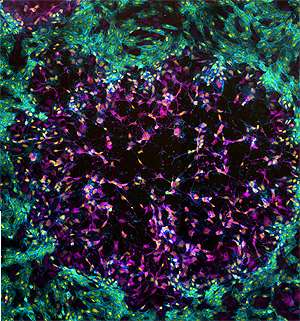Green fluorescent protein expressing vaccinia virus (pink) spreads from a single infected cell through an entire monolayer of green monkey kidney cells (blue with yellow nuclei) over three days.
(Phys.org)—A dramatic image of a virus replicating and spreading through cells, destroying them as it goes, has been captured by University of Sydney researchers.
As featured in the prestigious Cell magazine as part of their Cell Picture Show the technique used to create the image also helps calculate the level of infectious virus present in cells.
"The image shows vaccinia virus, the live-virus vaccine used to eradicate smallpox, spreading from a single infected cell through an entire layer of monkey kidney cells," said Dr Timothy Newsome. Dr Newsome and Dean Procter, a PhD student from his laboratory at the University's School of Molecular Bioscience, collaborated with colleagues from the Australian National University to create the image.
This is part of Dr Newsome's research on understanding the role of viral genes in viral biology and the effect that mutating these genes has on the viruses' ability to cause disease.
The image is fittingly titled 'Eye of the Storm' to convey the sense of seeing the starting point of the viral activity in the cells.
"The image is actually a composite of several smaller images taken in the microscope facility in the School of Molecular Bioscience," said Procter.
"To create them we work with the ideal dilution of highly concentrated virus so that only a few cells are infected. That allows us to monitor the spread of the virus through the uninfected cell layer."
Three days after the initial infection, the cells are chemically fixed, creating a snapshot of the infection at this stage.
"We then use fluorescent chemicals to highlight the structures in the cell we want to concentrate on. In this case pink virus-infected cells, yellow DNA and a turquoise skeleton," Procter said.
Viral plaques are patches of cells infected by viruses that have a distinctly different appearance because of cell death, movement or a change in cell structure. By counting the number of viral plaques in a layer of cells molecular bioscientists can figure out how much virus is circulating in a host or the concentration of viruses they work with in the laboratory.
"The degree to which viruses change the appearance of cells they infect inside a plaque can help us understand how pathogenic the virus is. This is a particularly beautiful technique used in our lab to discover whether the mutations we make in the virus affect their ability to cause disease," said Procter.
Journal information: Cell
Provided by University of Sydney




















